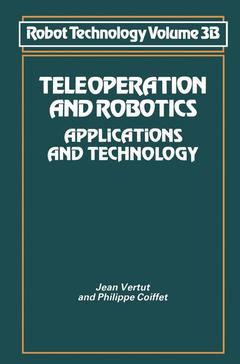Teleoperation and Robotics, Softcover reprint of the original 1st ed. 1985 Applications and Technology NSRDS Bibliographic Series, Vol. 3 B
Langue : Anglais
Coordonnateur : Vertut Jean

It is a privilege to be asked to introduce this important work. Such a book has long been needed. Industrial manipulators and robots have caught the attention of the general public and become very fashionable in the last few years. The casual reader of current newspapers and magazit:les or the viewer of television and films might easily conclude that the development of mechanical hands, arms and legs or other mobility devices has progressed rapidly in only the last few years. Most people are unaware of the gradual orderly succession of creative designs and painstaking refinements which have been produced over a greater number of years. That story is carefully described in this volume, together with diagrams and photographs which document in detail this elegant phase in the history of machine design. This volume together with Volume 3A constitute the most complete and comprehensive work on manipulators and teleoperators. Jean Vertut and Philippe Coiffet are well known not only as authors but also as engineers who have produced some of the finest devices in the world. Of course for the complete history of manipulators and teleoperators one must look back to the artisans who crafted the delightful clock works, mechanical puppets and toys before and during the Renaissance.
2 The contribution of computer science.- 2.1 A description of teleoperation systems.- Teleoperation with mechanical transmission.- Teleoperation with electrical transmission (unilateral control or bilateral servocontrol).- Computerized teleoperation.- Comments on this description.- The overall function of data processing in teleoperation.- Conclusions.- 2.2 The operator substitution function by computer.- Elimination of the human operator upon request.- Parallel action of the operator and the computer on different systems to ensure their coupling.- Modification to the master-slave transmissions for movement or force (to help manipulation).- Conclusions.- 2.3 The use of computer feedback to the operator.- Making use of the senses.- The choice of data to be transmitted to the operator.- Whether, and in what form, to present visual signals to the operator.- Redundancy and complementarity of vision and touch.- Conclusions.- 3 Performance and the man-machine interface.- 3.1 Performance evaluation of teleoperation systems.- How can the performance of a teleoperation system be defined and assessed?.- Qualitative performance: manipulator properties.- Towards quantitative performance measurement.- Conclusions.- 3.2 The human operator in the teleoperation system.- The man-manipulator interface.- Demands of the remote manipulation task.- Strategy for task execution.- The design of the workstation.- Analysis of work in real situations and evaluation of the work load.- Performance evaluation of remote manipulator systems under different experimental conditions.- Comparison of the different models of mechanical master-slave manipulators in experimental situations.- Ergonomic consequences of the technological advances in teleoperation.- 4 Applications of teleoperation.- 4.1 Nuclear applications.- Research and pilot facilities.- Operation and maintenance of industrial nuclear facilities.- Decommissioning and dismantling nuclear facilities.- Emergency intervention.- Conclusions.- 4.2 Underwater applications.- Manned submarines.- Cable-controlled devices (Busby, 1981).- Free-swimming underwater vehicles.- Inspection, maintenance and construction of underwater facilities.- Undersea mining: poly metallic nodules.- Conclusions.- 4.3 Space applications of teleoperation.- Planetary exploration and experimentation.- Satellite maintenance and servicing.- Assembly and maintenance of large space stations.- Conclusions.- 4.4 Medical applications of teleoperation.- Teleoperation for handling and transporting patients in hospital.- Applied teleoperation for patients with motor handicaps.- Telesurgery.- Conclusions.- 4.5 Industrial applications of teleoperation.- Applications in metallurgy and forging.- Public works applications.- Mining applications.- Handling objects that cannot be modelled by computer.- Work on high voltage power lines.- Conclusions: promises of industrial servicing robotics.- 4.6 Applications in security and civil protection.- Fighting fires and saving lives.- Applications in bomb defusing and disposal, and the police force.- Applications of legged locomotion.- 4.7 Conclusion.
Date de parution : 06-2012
Ouvrage de 256 p.
15.5x23.5 cm
Disponible chez l'éditeur (délai d'approvisionnement : 15 jours).
Prix indicatif 52,74 €
Ajouter au panier
© 2024 LAVOISIER S.A.S.



